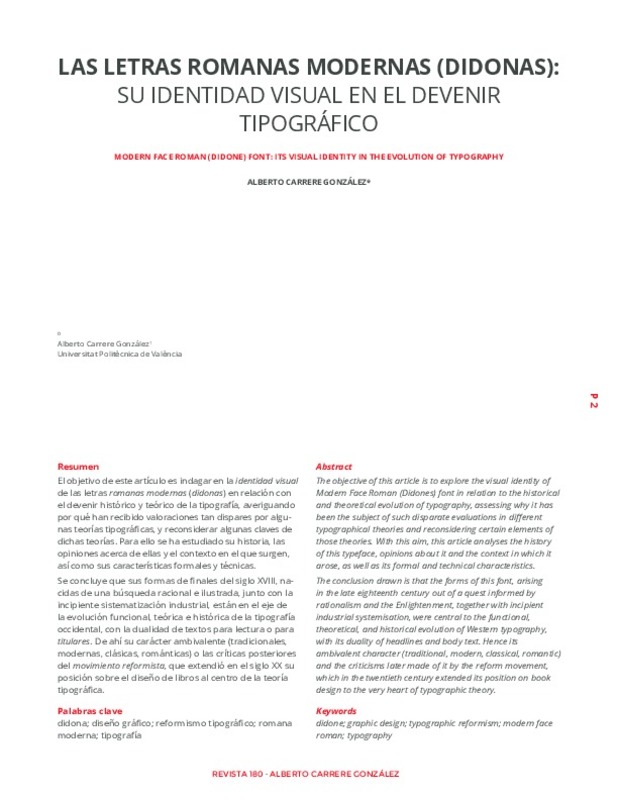JavaScript is disabled for your browser. Some features of this site may not work without it.
Buscar en RiuNet
Listar
Mi cuenta
Estadísticas
Ayuda RiuNet
Admin. UPV
Las letras romanas modernas (didonas): su identidad visual en el devenir tipográfico
Mostrar el registro sencillo del ítem
Ficheros en el ítem
| dc.contributor.author | Carrere González, Alberto
|
es_ES |
| dc.date.accessioned | 2018-12-15T21:00:41Z | |
| dc.date.available | 2018-12-15T21:00:41Z | |
| dc.date.issued | 2017 | es_ES |
| dc.identifier.issn | 0718-2309 | es_ES |
| dc.identifier.uri | http://hdl.handle.net/10251/113824 | |
| dc.description.abstract | [EN] The objective of this article is to explore the visual identity of Modern Face Roman (Didones) font in relation to the historical and theoretical evolution of typography, assessing why it has been the subject of such disparate evaluations in different typographical theories and reconsidering certain elements of those theories. With this aim, this article analyses the history of this typeface, opinions about it and the context in which it arose, as well as its formal and technical characteristics. The conclusion drawn is that the forms of this font, arising in the late eighteenth century out of a quest informed by rationalism and the Enlightenment, together with incipient industrial systemisation, were central to the functional, theoretical, and historical evolution of Western typography, with its duality of headlines and body text. Hence its ambivalent character (traditional, modern, classical, romantic) and the criticisms later made of it by the reform movement, which in the twentieth century extended its position on book design to the very heart of typographic theory. | es_ES |
| dc.description.abstract | [ES] El objetivo de este artículo es indagar en la identidad visual de las letras romanas modernas (didonas) en relación con el devenir histórico y teórico de la tipografía, averiguando por qué han recibido valoraciones tan dispares por algunas teorías tipográficas, y reconsiderar algunas claves de dichas teorías. Para ello se ha estudiado su historia, las opiniones acerca de ellas y el contexto en el que surgen, así como sus características formales y técnicas. Se concluye que sus formas de finales del siglo XVIII, nacidas de una búsqueda racional e ilustrada, junto con la incipiente sistematización industrial, están en el eje de la evolución funcional, teórica e histórica de la tipografía occidental, con la dualidad de textos para lectura o para titulares. De ahí su carácter ambivalente (tradicionales, modernas, clásicas, románticas) o las críticas posteriores del movimiento reformista, que extendió en el siglo XX su posición sobre el diseño de libros al centro de la teoría tipográfica. | es_ES |
| dc.language | Español | es_ES |
| dc.publisher | Facultad de Arquitectura, Arte y Diseño, Universidad Diego Portales | es_ES |
| dc.relation.ispartof | Revista 180. Arquitectura, arte, diseño | es_ES |
| dc.rights | Reserva de todos los derechos | es_ES |
| dc.subject | Didone | es_ES |
| dc.subject | Graphic design | es_ES |
| dc.subject | Typographic reformism | es_ES |
| dc.subject | Modern face roman | es_ES |
| dc.subject | Typography | es_ES |
| dc.subject.classification | PINTURA | es_ES |
| dc.title | Las letras romanas modernas (didonas): su identidad visual en el devenir tipográfico | es_ES |
| dc.title.alternative | Modern face roman (didone) font: its visual identity in the evolution of typography | es_ES |
| dc.type | Artículo | es_ES |
| dc.rights.accessRights | Abierto | es_ES |
| dc.contributor.affiliation | Universitat Politècnica de València. Departamento de Pintura - Departament de Pintura | es_ES |
| dc.description.bibliographicCitation | Carrere González, A. (2017). Las letras romanas modernas (didonas): su identidad visual en el devenir tipográfico. Revista 180. Arquitectura, arte, diseño. (40):2-12. doi:10.32995/rev180.Num-40.(2017).art-391 | es_ES |
| dc.description.accrualMethod | S | es_ES |
| dc.relation.publisherversion | http://www.revista180.udp.cl/index.php/revista180/article/view/391/346 | es_ES |
| dc.description.upvformatpinicio | 2 | es_ES |
| dc.description.upvformatpfin | 12 | es_ES |
| dc.type.version | info:eu-repo/semantics/publishedVersion | es_ES |
| dc.description.issue | 40 | es_ES |
| dc.relation.pasarela | S\355987 | es_ES |






